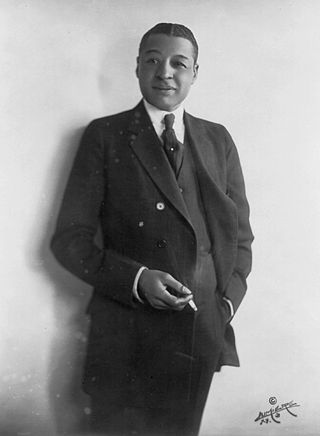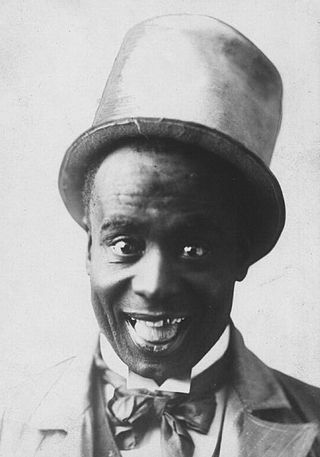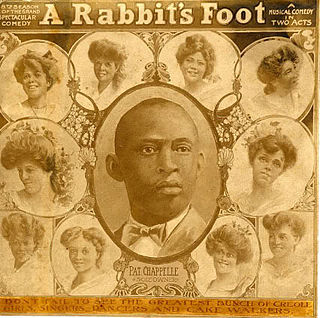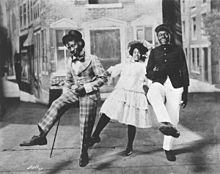
Bert Williams was a Bahamian-born American entertainer, one of the pre-eminent entertainers of the vaudeville era and one of the most popular comedians for all audiences of his time. While some sources have credited him as being the first Black man to have a leading role in a film with Darktown Jubilee in 1914, other sources have credited actor Sam Lucas with this same distinction for a different 1914 film, the World Film Company's Uncle Tom's Cabin. Ebony stated that "Darktown Follies was the first attempt of an independent film company to star a black actor in a movie", and credited the work as beginning a period in independent American cinema that explored "black themes" within works made for African-American audiences by independent producers.

Robert Allen Cole Jr. was an American composer, actor, and playwright who produced and directed stage shows. In collaboration with Billy Johnson, he wrote and produced A Trip to Coontown (1898), the first musical entirely created and owned by black showmen. The popular song La Hoola Boola (1898) was a result of their collaboration. Cole later partnered with brothers J. Rosamond Johnson, a pianist and singer, and James Weldon Johnson, a pianist, guitarist and lawyer, creating more than 200 songs.

William Mercer Cook, better known as Will Marion Cook, was an American composer, violinist, and choral director. Cook was a student of Antonín Dvořák. In 1919 he took his New York Syncopated Orchestra to England for a command performance for King George V of the United Kingdom, and tour. Cook is probably best known for his popular songs and landmark Broadway musicals, featuring African-American creators, producers, and casts, such as Clorindy, or The Origin of the Cake Walk (1898) and In Dahomey (1903). The latter toured for four years, including in the United Kingdom and United States.

In Dahomey: A Negro Musical Comedy is a landmark 1903 American musical comedy described by theatre historian Gerald Bordman as "the first full-length musical written and played by blacks to be performed at a major Broadway house." It features music by Will Marion Cook, book by Jesse A. Shipp, and lyrics by poet Paul Laurence Dunbar. It was written by Jesse A. Shipp as a satire on the American Colonization Society's back-to-Africa movement of the earlier nineteenth century.

American popular music is popular music produced in the United States of America and is a part of American pop culture. Distinctive styles of American popular music emerged early in the 19th century, and in the 20th century the American music industry developed a series of new forms of music, using elements of blues and other genres. These popular styles included country, R&B, jazz and rock. The 1960s and 1970s saw a number of important changes in American popular music, including the development of a number of new styles, such as heavy metal, punk, soul, and hip hop.

Shuffle Along is a musical composed by Eubie Blake, with lyrics by Noble Sissle and a book written by the comedy duo Flournoy Miller and Aubrey Lyles. One of the most notable all-Black hit Broadway shows, it was a landmark in African-American musical theater, credited with inspiring the Harlem Renaissance of the 1920s and '30s.

Sam Lucas was an American actor, comedian, singer, and songwriter. Sam Lucas's exact date of birth is disputed. Lucas's year of birth, to freed former slaves, has also been cited as 1839, 1841, 1848 and 1850.

Ernest Hogan was the first Black American entertainer to produce and star in a Broadway show, The Oyster Man in 1907, and helped to popularize the musical genre of ragtime.

Coon songs were a genre of music that presented a stereotype of Black people. They were popular in the United States and Australia from around 1880 to 1920, though the earliest such songs date from minstrel shows as far back as 1848, when they were not yet identified with "coon" epithet. The genre became extremely popular, with white and Black men giving performances in blackface and making recordings. Women known as coon shouters also gained popularity in the genre.

George Walker was an American vaudevillian, actor, and producer. In 1893, in San Francisco, Walker at the age of 20 met Bert Williams, who was a year younger. The two young men became performing partners. Walker and Williams appeared in The Gold Bug (1895), Clorindy (1898), The Policy Player (1899), Sons of Ham (1900), In Dahomey (1903), Abyssinia (1906), and Bandanna Land (1907). Walker married dancer Ada Overton, who later also was a choreographer.

Black Vaudeville is a term that specifically describes Vaudeville-era African American entertainers and the milieus of dance, music, and theatrical performances they created. Spanning the years between the 1880s and early 1930s, these acts not only brought elements and influences unique to American black culture directly to African Americans but ultimately spread them beyond to both white American society and Europe.

Clorindy, or The Origin of the Cake Walk is a one-act musical by composer Will Marion Cook and librettist Paul Laurence Dunbar.

Jesse Allison Shipp, Sr. was an American actor, playwright, and theatrical director, who is best remembered as a pioneer African-American writer of musical theater in the United States, and as the author of the book upon which the landmark play In Dahomey was based. Shipp played an influential role in expanding black theater beyond its minstrel show origins and is recalled as perhaps the first African-American director of a Broadway performance.

John William Isham was an American vaudeville impresario who was known for his Octoroons and Oriental America shows. These had their roots in traditional minstrel shows but included chorus girls, sketches and operas. They were part of the transition to the American burlesque shows of the early 20th century.

George Walker and Bert Williams were two of the most renowned figures of the minstrel era. However the two did not start their careers together. Walker was born in 1873 in Lawrence, Kansas. His onstage career began at an early age as he toured in black minstrel shows as a child. George Walker became a better known stage performer as he toured the country with a traveling group of minstrels. George Walker was a "dandy", a performer notorious for performing without makeup due to his dark skin. Most vaudeville actors were white at this time and often wore blackface. As Walker and his group traveled the country, Bert Williams was touring with his group, named Martin and Selig's Mastodon Minstrels. While performing with the Minstrels, African American song-and-dance man George Walker and Bert Williams met in San Francisco in 1893. George Walker married Ada Overton in 1899. Ada Overton Walker was known as one of the first professional African American choreographers. Prior to starring in performances with Walker and Williams, Overton wowed audiences across the country for her 1900 musical performance in the show Son of Ham. After falling ill during the tour of Bandana Land in 1909, George Walker returned to Lawrence, Kansas where he died on January 8, 1911. He was 38.
J. Edward Green was an actor, playwright and production manager in the United States. He was born in New Albany, Indiana in 1871. In his early years, he was part of the Black American Troubadours, Black Patti's Troubadours, Scott's Real Refined Negro Minstrels, the King and Bush Colored Minstrels, and Rusco & Holland's Minstrels. He organized the Rag Time Opera Company in 1901 in Birmingham, Alabama, where he produced two musical plays, African Princes and Medicine Man. For several years, he was the straight man for Ernest Hogan, sometimes called the father of ragtime. In September 1906, Robert Motts hired Green to be the Director of Amusements at the Pekin Theatre, replacing Charles S. Sager. While there, he authored, directed, and acted in shows, staging works including musical comedies Captain Rufus, In Zululand, The Man from 'Bam, Mayor of Dixie, Two African Princes, Honolulu, Queen of the Jungles, Twenty Minutes from State Street, My Nephew's Wife, My Friend from Georgia, A Trip to Coontown, The Count of No Account, In Eululand, The Grafters and Doctor Dope. Doctor Dope was by Stanley Woods (playwright).
A Trip to Coontown is an American musical comedy. It was performed, directed, and produced by African-Americans. It was written and performed in by Bob Cole and Billy Johnson. and debuted it New Jersey in 1897 before touring in the U.S. and internationally. Its New York City debut was at the Third Avenue Theatre on April 4, 1898.
Willis J. Accooe was an American performing musician and composer, mainly of musicals. He was "an important songwriter during the birth of the black musical" according to the Library of Congress website.
African American comedy has had a substantial role in American culture from minstrel shows, vaudeville, blackface, and coon songs to some of the world's most popular comedians, shows and filmmakers.
Andrew Tribble (1879–1935) was an African-American actor, comedian and female impersonator of the early 20th century who played a variety of women characters at Chicago's Pekin Theatre, on Broadway and in touring companies throughout the United States. He is best known for his characters Lily White, a washerwoman, and Ophelia Snow, from Cole and Johnson's production The Red Moon. He has been described as "a real genius" and "one of the greatest female impersonators".
















